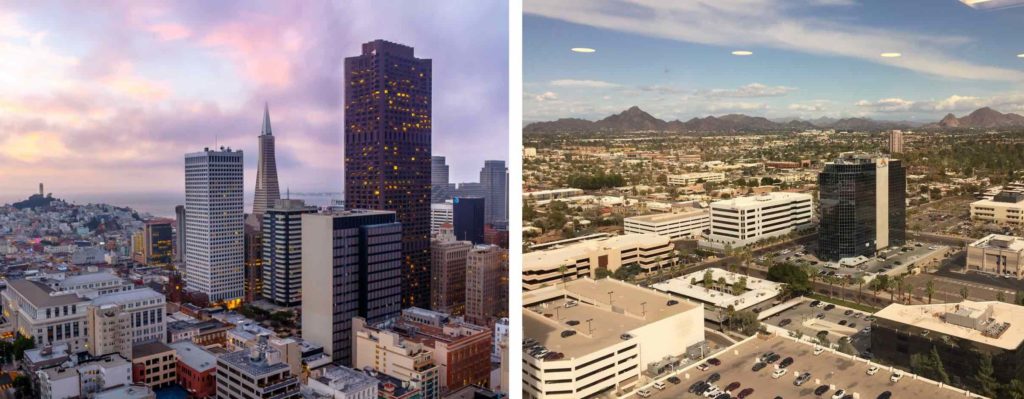The SaaStr annual conference in San Francisco had several thousand early stage software company founders and leaders. This conference has doubled in size in each of the last two years. Then, earlier this week, I hosted the first SaaS Day at PHX Startup Week – a day filled with expert speakers who shared lessons and stories with fellow software founders in Arizona. Over 500 people showed up for this mini-conference in the “Valley of the Sun” to learn how to grow their software companies and start new ones.
What were the differences between Silicon Valley and Phoenix software conferences?
Obviously, the Silicon Valley event had a much bigger crowd and bigger buzz.
Were the software leaders better or smarter in Silicon Valley? No.
Were the session topics very different in Silicon Valley? Nope.
Were the struggles of creating a company different for Silicon Valley founders? Mostly not.
Phoenix is not Silicon Valley. However, we need to stop perpetuating the myths that “you can only build a big software business in Silicon Valley” and “we don’t build big software companies in Phoenix.” Unfortunately, these perceptions run deep and continue to limit the thinking of capable tech entrepreneurs in Phoenix and everywhere else.
I helped grow two $100M+ software companies in Phoenix when I stopped believing those two myths.
So what is different about the Silicon Valley crowd compared to the Phoenix crowd?
This is a question that I have been thinking about since I moved to Silicon Valley 24 years ago, and then left a few years later to help start SalesLogix in Phoenix.
I see three important things that are different in Silicon Valley as a whole compared to Phoenix.
1. Ambition. Generally, Silicon Valley software founders and leaders think bigger and aim higher than software entrepreneurs in Phoenix. Silicon Valley entrepreneurs are known for tackling bigger, global problems and creating valuable companies that solve those problems. Venture capital investors help support and foster this ambition. Silicon Valley VCs are surprised that entrepreneurs in other areas don’t think as big (even though most VC-funded startups don’t actually get big).
2. Intensity. This is a big difference between Silicon Valley leaders and those in burgeoning tech centers. Silicon Valley entrepreneurs play very hard. Sometimes this means working more hours, but generally it’s a mindset of going for broke, increasing speed, and doing hard things more aggressively than other entrepreneurs. Phoenix has more “lifestyle” businesses that are steady but not big, and fewer that play the extreme sport of growing to $50 million or a billion dollars in revenue.
3. Connectedness. Silicon Valley tech leaders know they are on the front lines of the technology revolution and believe they are creating it for the rest of the world. Therefore, the real savvy and knowledge exists in their heads and those of their peers and local experts who are playing the same growth game. There is a high-intensity game of connecting, sharing, helping and communicating that moves faster than anywhere else through fluid networks of people. People come from all over the world to be part of this active community.
These are big advantages to being in San Jose, Palo Alto or San Francisco. While all these things are easier to do in Silicon Valley than in Phoenix, they are truly just mindset choices that anyone anywhere can make. They just seem normal in Silicon Valley because “everyone is doing it.”
This is déjà vu for me. When I moved from Dallas to San Jose in 1993 (when ACT! was sold to Symantec), it took me just a few months to dispel my belief that Silicon Valley was a place filled with a “different breed playing a different game” than software leaders elsewhere. I immediately learned that Silicon Valley is just filled with smart people (like you find everywhere) playing the growth game harder, faster and more collectively than in other areas.
I was already playing the game hard, moving fast and connecting with other entrepreneurs, so I fit right in. I left San Jose to be a cofounder of a company in Phoenix that grew from nothing to $100 million with an IPO in five years.
Bam! I changed my thinking and the results changed quickly.
Of course, almost everyone in Phoenix said, “you can’t do that here” –until we did. We were already used to being pioneers that made “crazy” new things that weren’t obvious to everyone else.
Opportunity exists when something clearly makes sense to a few people, but the rest of the world doesn’t see it the same way (or is hostile to the new idea). When you “see a new future arriving but it isn’t evenly distributed” yet, to adapt William Gibson’s quote.
Two “Valleys” with different perceptions that create different mindsets, which create the actions and results.
This is a lesson for anyone who is growing a business that isn’t “normal” in the eyes of others yet.
- Do you believe in your vision when other people don’t or when it isn’t perfectly obvious yet?
- Is your vision aligned with big trends that you can see clearly?
- How can you connect with others who see the world similarly to accelerate your thinking and intensify your actions?
- When did you first realize you were abnormal and unreasonable?!

